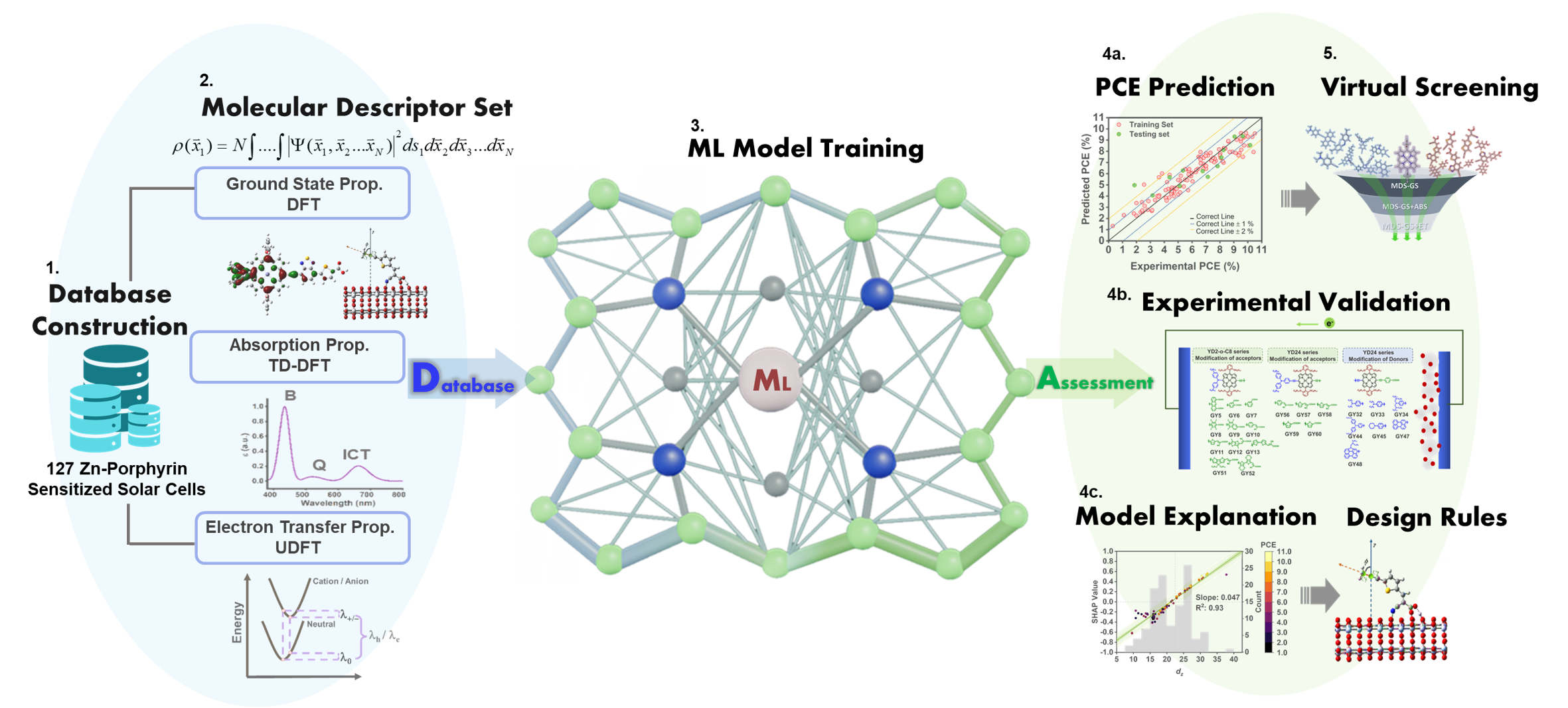



Dye-sensitized solar cells (DSCs) are becoming increasingly popular in the field of photovoltaics due to their cost-effectiveness, flexibility, and stability. However, understanding the relationship between the molecular structure of key components, such as zinc-based porphyrin sensitizers, and their performance in DSCs is challenging. In this study, we have developed a reliable and easy-to-understand model to predict the efficiency of these sensitizers.
Our approach combines machine learning techniques with density functional theory (DFT) calculations, using a dataset of 127 valid data points. The machine learning model is trained to predict the power conversion efficiency (PCE) of DSCs and is further explained using the Shapley Additive Explanations theory. This model demonstrates exceptional accuracy, with a mean absolute error (MAE) of 0.93% based on 10-fold validation testing.
Using this model, we conducted virtual screening of a wide range of molecules, derived from well-known and readily synthesized sources. As a result, we successfully identified ten promising zinc-based porphyrin dyes with high PCE. Additionally, by applying the Shapley Additive Explanations theory, we gained insights into the chemical rules that influence the performance of these dyes. These rules are expected to guide the development of design principles for practical applications of DSCs

The following steps will guide you through the use of the DSC-Meta web server for PCE prediction, making it a straightforward and accessible tool.
Before Prediction (Geometry Optimization)
Before submitting your sensitizer for Power Conversion Efficiency (PCE) prediction using DSC-Meta MGS-GS.
You can optimize its geometry using Density Functional Theory (DFT) with Gaussian 16 (G16).
Use the following keyword for optimization: "opt b3lyp/6-31g(d,p) scrf=(cpcm,solvent=thf)" This will generate a geometry optimization log file.
Save this file with a filename containing fewer than 26 alphabetic characters.
See the sample input file here. See the sample log file here.
The following steps will guide you through the use of the DSC-Meta web server for PCE prediction, making it a straightforward and accessible tool.
Before Prediction (TDDFT EDDM)
Before submitting your sensitizer for Power Conversion Efficiency (PCE) prediction using DSC-Meta MDS-GS+ABS.
You not only need an optimization file but also a Time-Dependent Density Functional Theory(TDDFT) EDDM file.
Use the following keyword for optimization: "opt b3lyp/6-31g(d,p) scrf=(cpcm,solvent=thf)" This will generate a geometry optimization log file.
Use the following keyword for TDDFT: "td=(nstates=20,root=1) b3lyp/6-31g(d,p) scrf=(cpcm,solvent=thf)"
And you need to input: "# b3lyp/6-31g(d,p) scrf=(cpcm,solvent=thf) pop=full iop(3/33=1,3/36=-1) geom=check guess=read" at the bottom of the gjf file.
By doing this, you can obtain a TDDFT EDDM file.
Save these file with a filename containing fewer than 26 alphabetic characters.
See the sample input TDDFT EDDM file here. See the sample TDDFT EDDM log file here.
The following steps will guide you through the use of the DSC-Meta web server for PCE prediction, making it a straightforward and accessible tool.
Before Prediction (ET)
Before submitting your sensitizer for Power Conversion Efficiency (PCE) prediction using DSC-Meta MDS-GS+ABS+ET.
You not only need an optimization file and a Time-Dependent Density Functional Theory(TDDFT) EDDM file but also an Electron Transfer(ET) file.
Use the following keyword for optimization: "opt b3lyp/6-31g(d,p) scrf=(cpcm,solvent=thf)" This will generate a geometry optimization log file.
Use the following keyword for TDDFT: "td=(nstates=20,root=1) b3lyp/6-31g(d,p) scrf=(cpcm,solvent=thf)"
And you need to input: "# b3lyp/6-31g(d,p) scrf=(cpcm,solvent=thf) pop=full iop(3/33=1,3/36=-1) geom=check guess=read" at the bottom of the gjf file.
By doing this, you can obtain a TDDFT EDDM file.
For ET file, we need to calculate the single point energy with charge = 1 and charge = -1, and calculate their optimization.
After calculating the optimization of charge = 1 and charge = -1, we also need to calculate the single point energy of both of them with charge = 0.
Save these file with a filename containing fewer than 26 alphabetic characters.
See the sample input ET file here. See the sample ET log file here.
